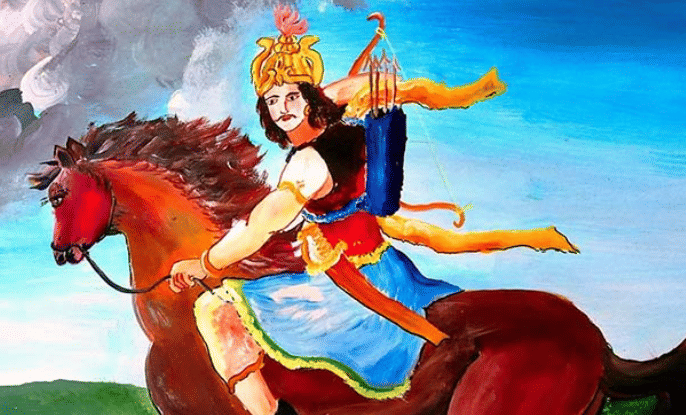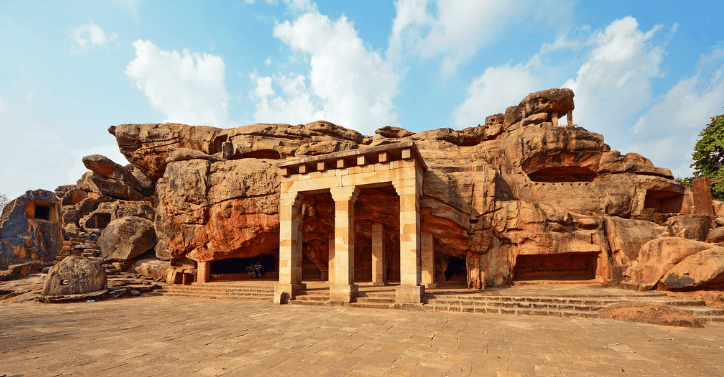UPSC Exam > UPSC Notes > History Optional for UPSC > Kharavela Dynasty
Kharavela Dynasty | History Optional for UPSC PDF Download
| Table of contents |

|
| Kharavela |

|
| Hathigumpha Inscription |

|
| Military Activities of Kharavela |

|
| Kharavela's Legacy |

|
Kharavela

The Great King of Kalinga
- Kharavela(193 BCE–170 BCE) was the most prominent king of the Mahameghavahana dynasty in ancient Kalinga, which is present-day Odisha, India.
- His reign marked a significant period of resurgence for Kalinga after the decline following the Mauryan Empire.
Sources of Information:
- The primary source of information about Kharavela comes from the Hatigumpha inscription, a famous rock-cut inscription consisting of seventeen lines.
- This inscription is located in a cave in the Udayagiri hills near Bhubaneswar, Odisha.
- According to the inscription, Kharavela belonged to the Chedi clan.
Restoration of Power:
- During Kharavela's reign, the Chedi dynasty of Kalinga rose to prominence.
- Kharavela played a crucial role in restoring the lost power and glory of Kalinga, which had been subdued after the war with Ashoka.
Military Campaigns and Expansion:
- Kharavela reinstated Kalinga's military might through a series of successful campaigns.
- He led expeditions against various regions, including Magadha,Anga, the Satavahanas, and down to the southern regions of the Pandyan Empire(modern Tamil Nadu).
- His conquests expanded Kalinga into a vast empire.
Defeating Rivals:
- Kharavela is credited with breaking the Tamil confederacy in the south, defeating western powers, and possibly overcoming an Indo-Greek king.
- After his victories, the first Sunga emperor of Magadha,Pushyamitra Sunga, acknowledged Kharavela's suzerainty and became a vassal of Kalinga.
- Pushyamitra also returned the Jina statue of Mahaveera to Kalinga as part of this relationship.
Achievements and Patronage:
- Within just ten years(from his 2nd to 12th regnal years), Kharavela achieved remarkable victories, extending his influence from the northwestern part of India to the southernmost regions.
- Despite being religiously tolerant, Kharavela was a patron of Jainism.
Maritime Trade and Influence:
- Under Kharavela's leadership, Kalinga developed a formidable maritime trade network.
- Trade routes linked Kalinga to distant regions such as Simhala(Sri Lanka),Burma(Myanmar),Siam(Thailand),Vietnam,Kamboja(Cambodia),Malaysia,Borneo,Bali,Samudra(Sumatra), and Jabadwipa(Java).
Later Years and Succession:
- Kharavela seems to have abandoned his throne in the 13th year of his reign.
- He was succeeded by his son Kudepasiri, who is mentioned in a few minor inscriptions.
Question for Kharavela DynastyTry yourself: What was one of the notable achievements of King Kharavela in terms of trade and influence?View Solution
Hathigumpha Inscription

Hathigumpha on Udayagiri Hills, Bhubaneswar
- The Hathigumpha Inscription, also known as the "Elephant Cave" inscription, was created by Kharavela in the 2nd century BCE.
- This inscription, consisting of seventeen lines written in deep-cut Brahmi letters, is found on a natural cavern named Hathigumpha on the southern side of Udayagiri Hill, near Bhubaneswar.
- The inscription faces the Rock Edicts of Ashoka at Dhauli, located about six miles away. While the former records the victory of Magadha, the latter commemorates the victory of Kalinga.
- It is dated to the 165th year of the Maurya kings' era and the 13th year of Kharavela's reign. Assuming Chandragupta's coronation in 321 BCE as the era's starting point, the inscription is dated to 157 BCE, and Kharavela's accession to 170 BCE.
- The Hathigumpha inscription begins with an invocation of the Arthatas and the Riddhas in the Jain tradition.
Military Activities of Kharavela
- In the second year of his coronation, Kharavela, undeterred by Satakarni, dispatched a large army to the west, comprising horses, elephants, infantry, and chariots. He also destroyed the capital of the Mushikas to assist the Kaspa (Kasyapa) Kshatriyas.
- In the fourth year, he conquered the Rathika and Bhojaka. The Rathika and Bhojaka chiefs, stripped of their crowns, umbrellas, royal insignia, and jewelry, were made to pay homage at Kharavela's feet.
- In the eighth year, Kharavela invaded Magadha, reaching as far as the Barabar Hills (Gorathagiri) and forcing a rival king, referred to as "Yavana-raja," to retreat to Mathura.
- In the twelfth year of his reign, he attacked the king of Uttarapatha, instilling fear among the people of Magadha and compelling their king to pay homage to Kharavela.
- Kharavela recovered holy idols of Kalinga's Jain Gods (The Blessed Tirthankars) that previous Magadha rulers had taken after the Kalinga War. He returned the Tirthankar's idol, complete with its crown and endowment, along with treasures plundered by King Nanda from the Kalinga royal palace, and the treasures of Anga and Magadha.
Achievements Beyond Military Activities:
- In the very first year of his coronation, Kharavela repaired the gate, rampart, and structures of Kalinga Nagari's fort, which had been damaged by a storm. He also built steps for the cool tanks and laid out gardens at a cost of thirty-five hundred thousand coins, pleasing all his subjects.
- In the third year, Kharavela, skilled in the Gandhavara-Veda or the science of music, organized theatrical performances, dances, and other shows to entertain the capital.
- In the fourth year, he repaired sacred buildings known as the adobe of the Vidyadharas.
- In the fifth year, Kharavela extended an old canal excavated by King Nanda 300 years earlier, bringing it into Kalinga Nagri through Tanasuli.
- In the sixth year, he granted privileges to the Paura and Janapada corporations.
- In the ninth year, Kharavela bestowed expensive gifts upon Brahmins, who accepted them with lavish feasts. He presented a Kalpa tree (a tree with golden leaves) along with gifts of elephants, horses, and chariots with their drivers. Kharavela constructed a grand palace called The Place of Victory on both banks of the Prachi River at a cost of 36 lakhs of silver coins.
- In the twelfth year, he built towers at home, intricately carved the interiors, and placed numerous trophies and presents inside them.
- In the thirteenth year, satisfied with the expansion of his empire, Kharavela turned his attention to religious acts. At Kumari Hill (Udayagiri), he undertook projects for the Arhat Temple.
- The inscription mentions ninety hundred bulls maintained by the king. He built some edifice, likely of stone, near the Arhat temple and erected a pavilion on four pillars. The cave containing this inscription was also created.
Kharavela's Legacy
- Kharavela is depicted as a king of peace and prosperity, a Bhukshu king, and a King of Dharma, dedicating his life to witnessing and experiencing Kalyanas.
- The inscription emphasizes Kharavela's liberal religious spirit, portraying him as a worshiper of all religious orders and a restorer of shrines for all gods.
- The conclusion of the Hathigumpha inscription highlights Kharavela's personality as a blend of Raj rishi and Dhamma Rishi. However, it's important to note that the inscription is a eulogy, and some claims made in it may be questionable. Additionally, while Kharavela was a conqueror, he was not an empire builder.

Minor Inscriptions of Kharavela:
- In addition to the famous Hathigumpha inscription, there are various minor Brahmi inscriptions found in the Udayagiri and Khandagiri Caves.
- These minor inscriptions, also written in Brahmi script and Prakrit language, provide insights into the reign and kingdom of Kharavela.
Question for Kharavela DynastyTry yourself: Which year did Kharavela invade Magadha and reach as far as the Barabar Hills?View Solution
The document Kharavela Dynasty | History Optional for UPSC is a part of the UPSC Course History Optional for UPSC.
All you need of UPSC at this link: UPSC
|
367 videos|995 docs
|
FAQs on Kharavela Dynasty - History Optional for UPSC
| 1. Who was Kharavela and what was his significance in ancient Indian history? |  |
Ans. Kharavela was a prominent ruler of the Kalinga kingdom in ancient India, known for his military conquests and cultural contributions during the 2nd century BCE. He is significant for his efforts to revive Jainism in the region and for his patronage of the arts, as evidenced by the Hathigumpha inscription that details his achievements and lineage.
| 2. What does the Hathigumpha inscription reveal about Kharavela's reign? |  |
Ans. The Hathigumpha inscription, located in the Hathigumpha cave near Bhubaneswar, provides a detailed account of Kharavela's genealogy, achievements, and military campaigns. It highlights his victories against various kingdoms, his devotion to Jainism, and his efforts to develop the infrastructure and economy of Kalinga.
| 3. What military activities did Kharavela undertake during his reign? |  |
Ans. Kharavela is known for his aggressive military campaigns against neighboring regions, including the conquest of Magadha and the suppression of various rival kingdoms. His military activities aimed to expand Kalinga's influence and secure trade routes, which contributed to the prosperity of his kingdom.
| 4. How did Kharavela contribute to the legacy of the Kharavela Dynasty? |  |
Ans. Kharavela's legacy is marked by his promotion of Jainism, patronage of art and architecture, and military success, which solidified the Kharavela Dynasty's influence in ancient India. His achievements are remembered as a golden era for Kalinga, and his inscription serves as a valuable historical source for understanding the period.
| 5. What impact did Kharavela's reign have on the cultural and religious landscape of Kalinga? |  |
Ans. Kharavela's reign had a profound impact on the cultural and religious landscape of Kalinga, as he actively supported Jainism and facilitated the construction of temples and monuments. His efforts to promote religious tolerance and cultural development fostered a rich environment for art, literature, and philosophy in the region.
Related Searches















